Note: Today’s post is from none other than Ingvar Hallstrom, whom some of you may remember from TTAC. Republished, and slightly revised, with his permission. Enjoy. -TK
To understand the Swedes’ love for the station-wagon, one has to go back to the war, the Second World War. Much of Sweden’s economy was built upon the fact that the country hadn’t been ravished by the war. While other countries built tanks and gunships, the Swedes developed cars for the glorious post war society they were sure would be built upon the rubble and ruins of Europe. Swedes were not going to spend their post-war years squeezed into tiny bubble cars. And in addition to proper family-sized cars, a roomy station wagon was called for.

The Volvo PV444 was presented in 1944, with deliveries started in 1947.

The Saab 92 appeared in 1949. The 92, PV444 and the Volkswagen were the cars of choice for the Swedish people throughout the ’50s. Though they were very popular, they weren’t exactly the most practical cars. The Saab didn’t even have an externally available luggage compartment for the first few years. Something had to be done.

Though the Volvo PV444 was of unibody construction, there was some pressure from the commercial sector to make chassis available for conversions. In 1949 Volvo presented a separate chassis on a ladder frame. It was equipped with engine, hood, front wings, front bulkhead and instrument panel. Outside coachbuilders made use of that and built various specials, like wagons, pickup trucks, fire engines and ambulances.
There were even some convertibles built, much in the style of the Chrysler Town & Country woodie convertibles, though on a lower scale. And sans wood framing.
 Pickup trucks were also a popular conversion.
Pickup trucks were also a popular conversion.

And roomy station wagons, naturally. Those were not the kind of crude Epa-tractor conversions I’ve talked about in the past, but rather outsourced, factory approved coachbuilt conversions. Of course they were quite expensive.
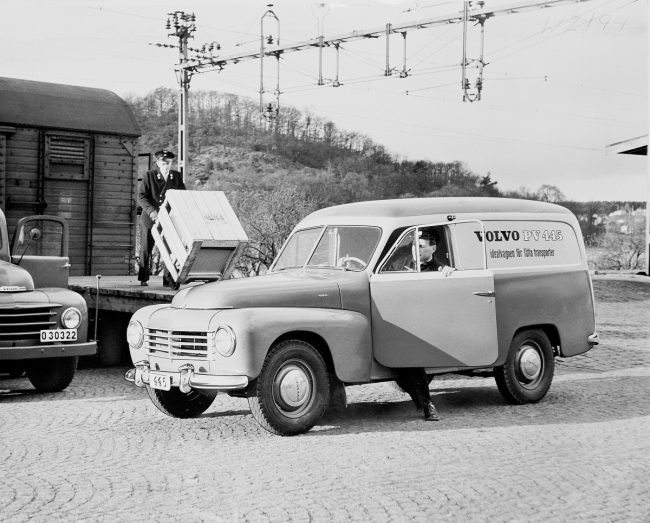
Market pressure then made it easier for Volvo to develop a less expensive wagon of their own, with an all steel body on the commercial chassis. The tell-tale between the versions are the rudimentary rear wings often fitted to the coachbuilt cars, where the factory version is rather clean and slab sided.

The new factory-built wagon was presented in 1953 as the Volvo PV 445, colloquially called the “Duett”, with the dual purpose of being used both “for work and pleasure.” It was marketed to artisans, craftsmen, shop-owners, and the like.
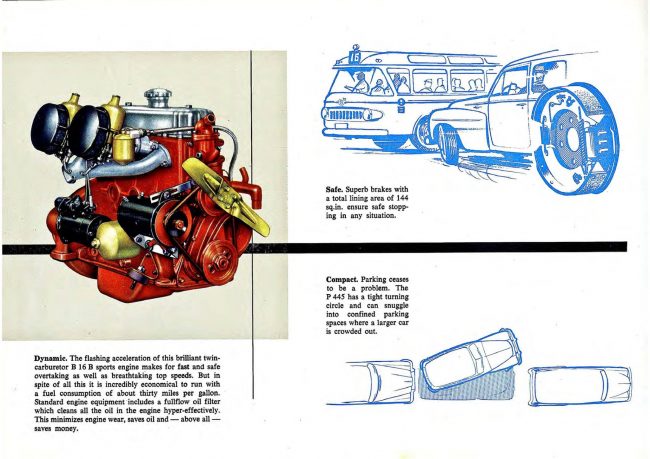
People who needed a practical wagon to make deliveries on week days, with the need to haul the family down to the beach or summer house come weekends. As practical cars go, it was essentially the only one of its kind in Sweden and therefore seen in much use.

It was also the car of choice for the various branches of the Swedish government. The bright orange cars from the national telephone company Televerket were a common sight, I remember seeing those in practical use up into the early 1980’s. Other large fleet buyers were the national railroad company SJ, who had their cars painted red with contrasting black front wings, while the national post office had their cars painted a bright yellow with contrasting black front wings.


The PV445 was modernized at the same pace as its sedan counterpart. In 1960 it received a minor facelift and became the P210. At the same time, production of bare commercial chassis ended after some 4,000 had been produced. In 1962, the 120-series “Amazon” station wagon was presented. It was a rather expensive solution due to the fact that it was of unibody construction.

The design staff virtually had to carve out a completely new rear end, from the B-pillars and back, with specially made rear doors, rear wings, a new roof, and a bi-split rear tail-gate. Because of that, it became more of an upscale family car, thus relegating the Duett to work horse capacity only.

And boy, did it see much of that. Not in the horse and buggy but more in the oxcart kind of style. People mistreated their cars in the most sadistic kind of way and still expected every car to do its duty. I wouldn’t be surprised if Volvo’s reputation for quality and durability wasn’t built upon the sheer beatings those cars were capable of withstanding. As one of Volvo’s ads proclaimed: “Drive it like you hate it.” One could dish it out, and the good old ‘Ovlov’ would come back for more.
It honed the people into the practical use of wagons and paved the way for generations upon generations of family haulers in Sweden, making the station wagon the most common car in the country.

In 1968, the Volvo 145 station wagon was presented. Interestingly enough, that year saw three overlapping generations of Volvo wagons being made, with that year being the final model year for the Amazon wagon. In 1969, the Duett was finally phased out, with a tally of roughly 90 000 cars produced.

The demise of the Duett left a hole for more practical cars in the line-up, and as a replacement of sorts the rather curious 145 Express was presented in 1970. The ten inch roof extension and larger tail-gate was made out of fiberglass, and simply just tacked on during production. With time, it has garnered a sort of cult following in Sweden.

When trying to describe the Volvo Duett, I keep looking for comparisons. But in the hearts and minds of the Swedish people there really isn’t anything like it, it transcends description. It’s like a Jeep Station Wagon but not as rugged, or like a Land Rover but without four-wheel drive.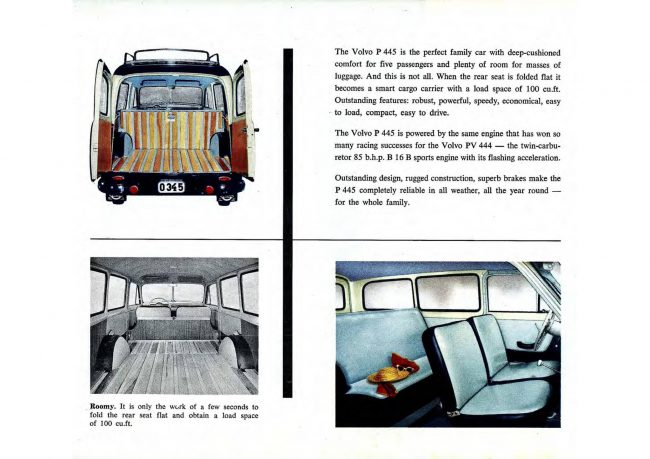 It has hippie connotations like a VW Bus, it has surfer credibility like a woodie wagon, it has anti-society vibes like a Citroen driven by a bunch of angry communists. It is unadorned like the girl next door, it is unpretentious like an Ikea dining room set, it is rugged and reliable as Sancho Panchas mule, and it is homely like a well worn Birkenstock.
It has hippie connotations like a VW Bus, it has surfer credibility like a woodie wagon, it has anti-society vibes like a Citroen driven by a bunch of angry communists. It is unadorned like the girl next door, it is unpretentious like an Ikea dining room set, it is rugged and reliable as Sancho Panchas mule, and it is homely like a well worn Birkenstock.
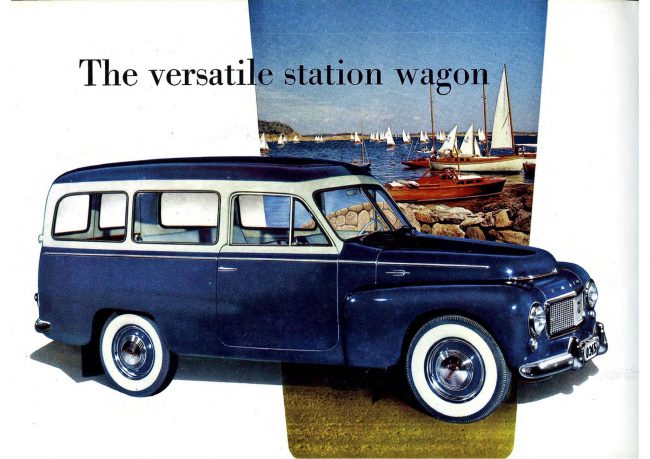
It is an anti-car made for those that knows that quality always wins over style, it is simply one of the most practical cars ever made.
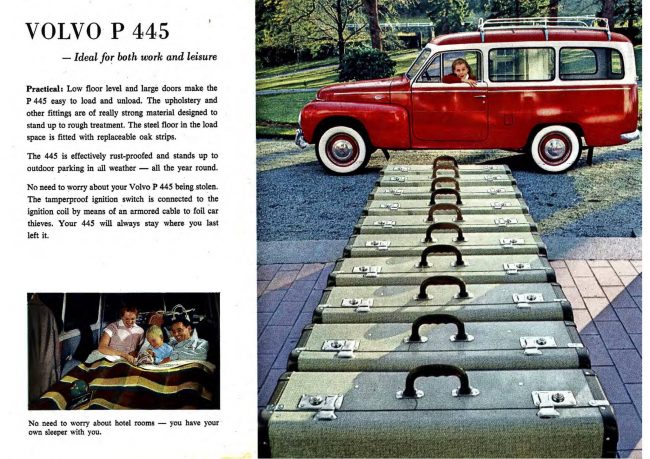


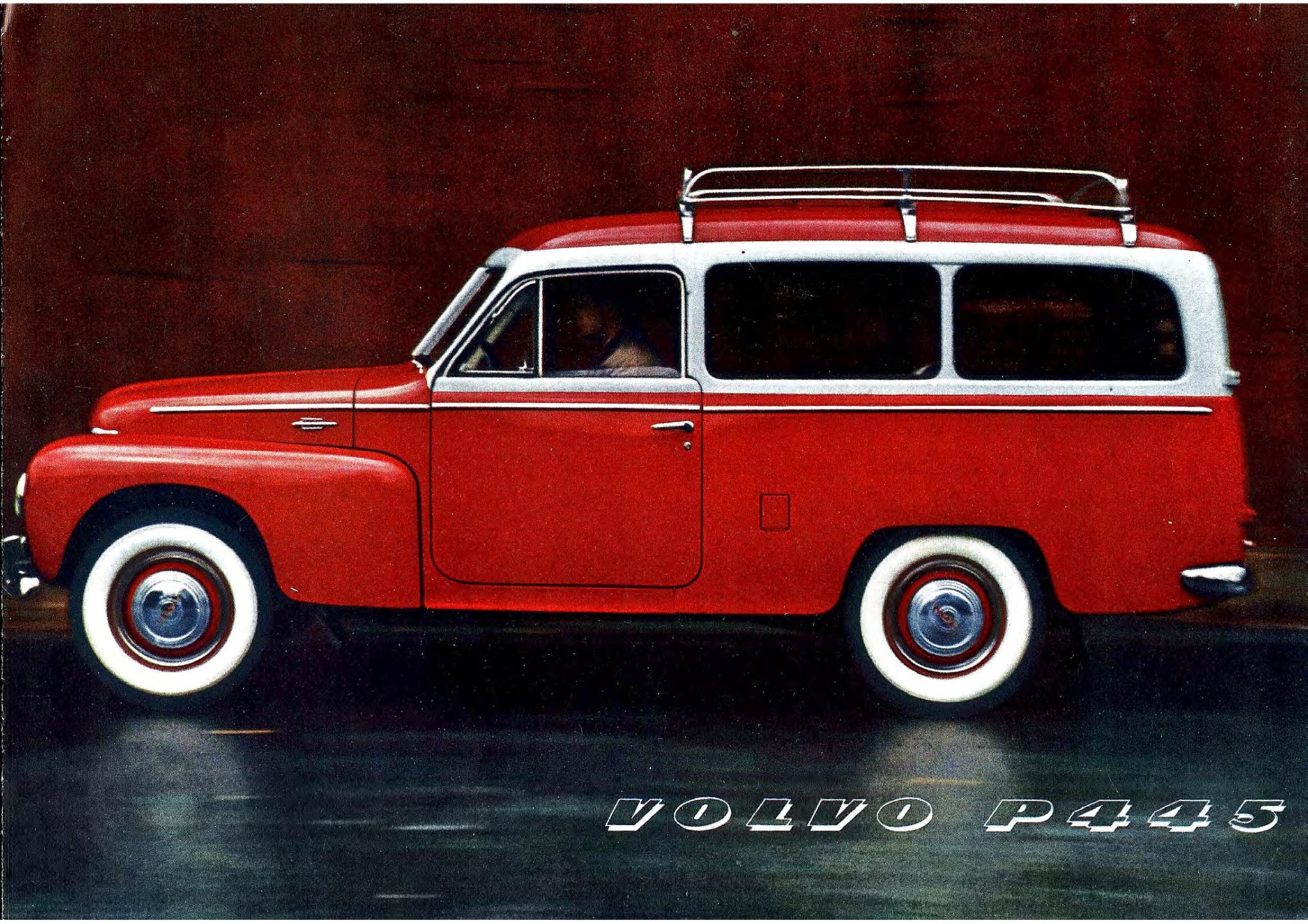



 Pickup trucks were also a popular conversion.
Pickup trucks were also a popular conversion.











 It has hippie connotations like a VW Bus, it has surfer credibility like a woodie wagon, it has anti-society vibes like a Citroen driven by a bunch of angry communists. It is unadorned like the girl next door, it is unpretentious like an Ikea dining room set, it is rugged and reliable as Sancho Panchas mule, and it is homely like a well worn Birkenstock.
It has hippie connotations like a VW Bus, it has surfer credibility like a woodie wagon, it has anti-society vibes like a Citroen driven by a bunch of angry communists. It is unadorned like the girl next door, it is unpretentious like an Ikea dining room set, it is rugged and reliable as Sancho Panchas mule, and it is homely like a well worn Birkenstock.







26 Comments
Thanks for this interesting write up Ingvar. What I find so interesting is how advanced countries developed cars specifically to their unique situation. This creates interesting vehicles that may have some slight export potential, of the kind that is easily reciprocated with other advanced countries. Thus no predatory wealth transfer. All of this is gone now with worldwide ownership, far and wide parts sourcing and now even international design teams for all the players.
My 2018 V90T5 Inscription is in a way a successor to this vehicle and while I am sure it is a common taxi in Scandinavia as V90D3, I can’t imagine it being used as roughly as the Duett. In my now two years of ownership, there as yet been an opportunity to carry something the sedan couldn’t have done better with it’s more noise sealed cargo hold.
So, Japanese bad but Chinese good? Got it!
I will leave the how wonderful the Asians are talk to you, Texn. You are always so full of it! Sometimes even in Spanish because the border crossed you right.
I learned my Spanish from all the labels on GMs hecho en Mexico, while living near the border of Canada. Enjoy your chi com vulva, and I will enjoy my US made vehicles. Practice what you preach, Johnny. Feliz Navidad anciano.
You are lucky you get your domestic assembly from Japanese manufacturers. They have so mastered the master/slave relationship as practiced for generations in Korea and Manchuria. Now they have brought it to the USA and despite lower pay and far lower benefits there is never any labor strife whatever. The workers know their place, on their knees. As Americans we are all learning our place.
Geely got the money it used to buy Volvo from Ford with loans from Goldman Sachs. Because of course Chinese money is not readily convertible and thus theoretical. Goldman Sachs being the investment firm not Sachs Goldman the impeachment lawyer. GS I will call American as to not do so would imply dual loyalty and I only believe they have one loyalty. GS gets the trademark when they default. Luckily for me, China has no ability to design cars so mine was still designed in Sweden. With no China interest in wagons, mine was assembled in Gothenburg, As per the window sticker, the major source of foreign parts was Sweden with 33 %. That is much higher than my wife’s old Belgium assembled 04 V70. The engine was from Sweden and the transmission was from Japan. Borg Warner seems to have also learned their place and now is Aisan Warner. How does the song go, “I say to myself, What a Wonderful World”.
You support communism (unions and sending money to China) and I’ll support my God-given freedom in this fine country. In fact, I’m going to enjoy the mountains majesty and head for the slopes.
Roomy and practical Volvo wagons from the days when Swedes were typically getting married and still having 2+ children. Then the high taxes necessary to finance the vast expansion of the post WW2 welfare state (including generous disability and pension benefits) were enacted, and children became expensive extravagances that were no longer needed to ensure a comfortable retirement. Now Swedes live alone with perhaps 1 child and no longer need big family wagons (or roomy sedans), and 25 year old unaccompanied “children” from Syria and Afghanistan are imported to replace the missing native Swedes while the most popular baby name in Stockholm is not Sven or Ole, but some variant of Mohammad. Lack of demand means Saab is gone and Volvo is owned by the Chinese, and it seems doubtful that the new children of Sweden will have the talent, abilities, and inclination to support Swedish industry or its welfare state, and natives who mention such uncomfortable facts are reported to the police and fined for hate speech.
It saddens me you feel the need to trash talk my country with such complete and utter nonsense. What you state are easily debunked rubbish spread in racist right wing circles, and it is a lie from beginning to end. Every single one of your statements is a lie!
Crime has gone steadily down for the last thirty years, and Sweden still ranks as one of the best countries in the world to live in, just because of the welfare state. And I’ve never met an American that wouldn’t give an arm and a foot for those kind of benefits we take for granted like free healthcare and dental and unemployment benefits and whatnots for the same taxes you pay over there.
But I’m not going to discuss these matters any further. Instead, I’d like to invite you to come and see for yourself. I’ve worked with the homeless, I’ve worked with the refugees, I’ve been all over the city in the middle of the night, and I’ve never been afraid of anything because I feel completely safe wherever I go. I’ll shack you up at my place, and we can take a stroll around the city and you can see for yourself. What do you say? You’re welcome…
Not saying that anyone is right or wrong but it appears that violent crime in Sweden is increasing. Heres a left wing perspective
https://www.politico.eu/article/sweden-bombings-grenade-attacks-violent-reality-undoing-peaceful-self-image-law-and-order/
Keeping citizens afraid is the easiest and cheapest way of controlling them, thank you for your input Ingvar .
-Nate
Nate – the Swedish welfare state was designed by the Social Democrats (Bernie Sanders equivalents) to keep the citizens from being afraid of getting sick, unemployed, or getting old by providing “free” healthcare, welfare, and pensions, etc.. and consequently voting consistently for the Social Democrats in gratitude. Of course the “free” stuff wasn’t free, and Sweden at various points has had marginal income tax rates above 100%, 26% sales tax (VAT), and painfully high “sin” taxes on alcohol, tobacco, and most sinful of all gasoline and diesel, which the wealthy evade by moving out of Sweden and/or using their influence to occasionally elect a conservative government (as in Joe Biden conservative) to reign back the taxes a bit. The problem today is that the generous Swedish welfare state is attracting lots of unskilled and violent foreigners (they certainly aren’t coming to Sweden for the weather), who take out lots of benefits (and add costs for police, court, and prison systems) but almost never pay into the system because they are unemployable or adverse to real work.
The end result is the Sweden where citizens often didn’t feel a need to lock their homes and cars, and where women and children were unafraid to walk alone after dark in any city is now largely gone, and native Swedes are more worried about illness and old age because the State continually cuts back benefits in order to preserve resources to support the high needs of the new arrivals. And many Swedes are now afraid of talking about their fears, because the government is actively encouraging citizenry to spy on each other and report “hate” crimes such as questioning the generous immigration policies. And these new fears are changing the political scene as the Sweden Democrats are now the most popular political party even though competing parties and the media unfairly portray them as Nazis and Racist. The Sweden that Bernie Sanders thinks he knows and loves, is heading in the same direction as their former number 2 carmaker Saab.
Right off the bat in that link it mentions grenade attacks. I guess grenade attacks are an everyday thing in that country.
I was hearing about grenade attacks over there at least a year ago.
Most places would consider that terrorism even if it’s just settling personal scores. I guess they think different over there.
Well, you know, grenade attacks are just part and parcel of living in a vibrant community with many food trucks.
Oh shoot ~
Southern California had scads of food trucks .
? Maybe it’s a good thing my budget doesn’t allow me to patronize them often ? .
-Nate
I guess thats why Ignvar was bragging about someone from the US giving “an arm and a foot for those kind of benefits we take for granted like free healthcare ”
You need those benies after you loose an arm and a foot in a grenade attack…….
Thank you for the kind offer (and the nice Volvo write-up), but my wife is Swedish and I’ve visited the country many times over the past 35 years, and I stand by my statements. Unfortunately, too many Swedes are in denial about their immigrant problem, but then again it is nearly impossible to get statistics because the Swedish state stopped collecting crime statistics by ethnic/racial background in 2005, and the Swedish media is not interested in doing any investigative reporting on the issue because it wouldn’t support the “diversity is our strength” mantra. Yet there must be some reason why the open borders between Sweden and neighboring Norway and Denmark are not so open anymore (1st link), and why UPS and Post Norden have stopped delivering packages in several “no go” areas of Sweden (see 2nd link).
https://www.theguardian.com/world/2019/nov/12/denmark-border-checks-crossings-sweden
https://voiceofeurope.com/2019/02/ups-stops-delivering-packages-to-swedish-no-go-zones-after-multiple-attacks-on-drivers/
Is it true the Swedes sold Germans iron ore during the war?
I do a GOOGLE “sweden iron ore germans” and come up with over 10,000,000 hits.
Maybe that explains St. Greta the Hateful.
Volvo might leave Sweden due to all the recent diversity:
https://www.rt.com/news/463964-volvo-high-crime-rate-sweden/
Greta Thunberg probably doesn’t help either. Do you really want to work for a car company in a country where St Greta the Hateful was spawned?
Oy vey ! . so much vitriol .
In 1972 (=/-) I had an ‘interesting’ customer, Reverend Scoon, who had two of these in decent shape, I’d never seen one before and was enraptured .
“Speedy & flashing acceleration ” ? . obviously written by someone who never drove one .
Very stout and to me, good looking utility cars .
-Nate
Getting back to the car. I wonder about using such a small four in such a heavy commercial vehicle. The displacement seems to have risen over time from 1.4 -1.8 liters but the separate frame and wagon body must have really added weight. Volvo of course had truck engines that might have fit, but putting dual carbs on the red block seems the wrong direction as it adds complexity while helping horsepower more than the more important torque. As with the VW bus though, it would seem you had to be quite the died in the wool import buyer to pick one of these over a Rambler or Studebaker with their generous helpings of inline six or V8 power.
Build quality of PV and Amazon were far superior to a Rambler or Studebaker, along with much better rust proofing, more precise handling, and far better seats. With a real 4 speed gearbox instead of 3 on tree (with non-synchro first) or slushbox, the Volvo 4 would more than keep up with a Rambler or Studebaker 6 and get better MPG to boot, so there were rational reasons to buy a Volvo over an off-brand American, but I suspect most Volvo’s of that era were sold in the US as a means of being unique or exotic. I believe the red block was also used in many Volvo trucks and most of their farm tractors of the time (in single carb form), so it was a pretty versatile motor. In Sweden the Volvo was considered a pretty sporty car, as the most common alternative was a Beetle with about 30 hp.
Do you think if Volvo had offered the redblock derived inline six from the 164 in the Duett that the American buyers would have shunned it based on cost or mileage penalty? I suspect they would have snapped them up. Early imports really had their people make some big sacrifices to be different. I suspect even Swedish buyers were putting up with a lot to come to terms with their automakers very limited resources.
I am sure a 6 cylinder Amazon or Duett would have sold pretty well in the US, but Europeans in the 1950s and 60s were mostly too poor to afford a big thirsty car, so sixes tended to be only available on real upscale brands. The Swedes were better off than most because they made lots of money selling raw materials to the Nazis during the war and didn’t have their industry destroyed by B-17s, but even they were far behind the average wealth of Americans, and even back then Europeans taxed motor fuel far more than the US, so fuel was very expensive relative to their incomes. European makers also had to contend with various displacement taxes that got painful pretty fast in most European markets until relatively recently (Sweden was an exception in not using displacement taxes). Thus
it wasn’t until the late 1960s that US exports and the population of relatively well off Europeans got large enough to warrant European investments in larger motors for home and export markets.
Station wagon mafia, represent.
I’m reminded of the 50’s vintage Suburban a family friend of ours restored. It was at most mid-sized by today’s standards.
My 1960 Studebaker Lark was sold as a compact car. It’s bigger that what is today sold as “full size”.